Disclosure: Meeple Mountain received a free copy of this product in exchange for an honest, unbiased review. This review is not intended to be an endorsement.
Fjords originally came onto the board gaming scene back in 2005. Designed by Franz-Benno Delonge, (Container, Manila, Big City, and TransAmerica—a Mensa Best Mind Game winner for 2003), Fjords was a terse, 40-tile, two-player game that combined a hexagonal tile laying game with a point-scoring land acquisition phase, all of which could be played in about 20 minutes.
When Delonge died of cancer in 2007, the promotion of his games all but ended. Many people, myself included, felt this was an injustice done to a promising designer and some really fine games. In 2018 a 10th Anniversary Jumbo Edition of Container was successfully funded on Kickstarter, bringing Delonge’s shipping game back into print.
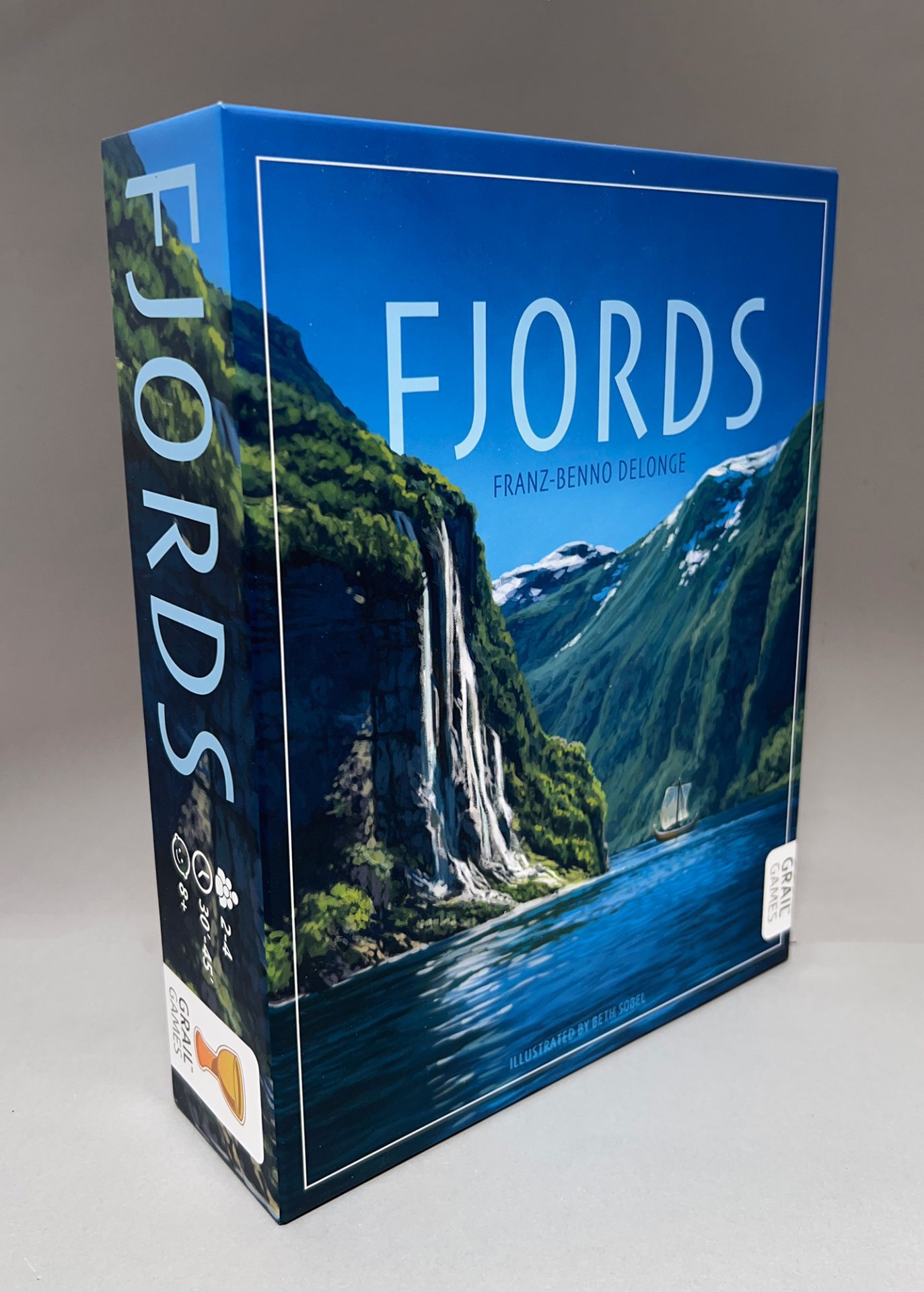
In 2021, a similar Kickstarter campaign was launched to bring Fjords back into print. This revised edition expanded on the original two-player game. With new artwork by Beth Sobel, new rule-bending Runes designed by Phil Walker-Harding, and pieces that would allow for up to four players, this was definitely a new version of Delonge’s original game.
If you, like me, were a fan of the original 2007 release of Fjords and are wondering if this is worth adding to your gaming shelves, feel free to skip down to the “Quick Comparison” section.
Otherwise, let’s dive into Fjords, shall we?
The Set Up
Let’s start at the beginning: Fjords is a game of hexagonal tiles, Longhouses and Viking settlers.

Start by having each player select a color and giving them the 4 Longhouses and 20 Vikings of that color.
In a two or three player game, take a look at each of the hexagonal tiles. Remove any that have a number on them higher than your player count. (Or, if you’re like me and think you can never have enough tiles in a game like this, leave them all in.)
At the same time, look through all the tiles with the green design on the back for the three tiles with a blue background. Take these out, as these will be your starting tiles.
Place the remaining tiles in the provided draw bag.

Fjords tiles come in three different environments: Plains (green), Mountains (white snow atop gray, rock edges), and Oceans (blue).
Arrange the three tiles such that the environments along two edges match with the other tiles.
And now you’re ready to play Fjords.
How to Play
On a turn, players will draw a tile from the bag and add it to the tiles already on the ever-evolving board. In this way, much like Carcassonne, you’ll be building your landscape as you go, only hexagonally.
Before placing that tile, there are a few essential rules concerning where and how tiles can be placed:

- You must place new tiles such that at least two edges of a new tile must be touching two other tiles.
- The environments depicted on those edges must match perfectly with the tiles already placed.
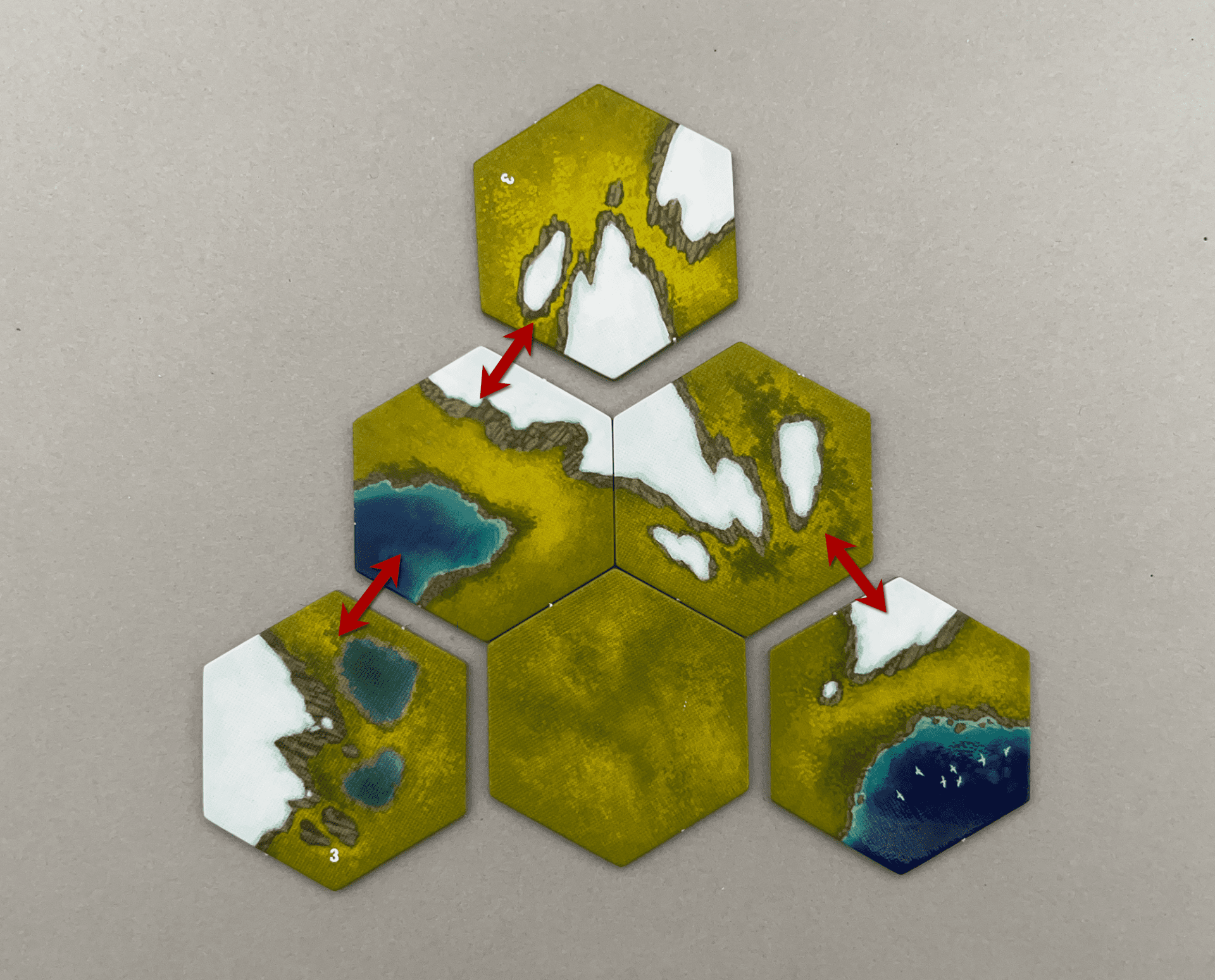
This means if a tile has a side that is half Ocean and half Plain, you cannot place it against a tile edge that is all Ocean or all Plain.
As well, all tiles must extend the original landmass. That Plain must form a single landmass; you cannot create a second landmass that is separated from the original either by Mountain or by Ocean.
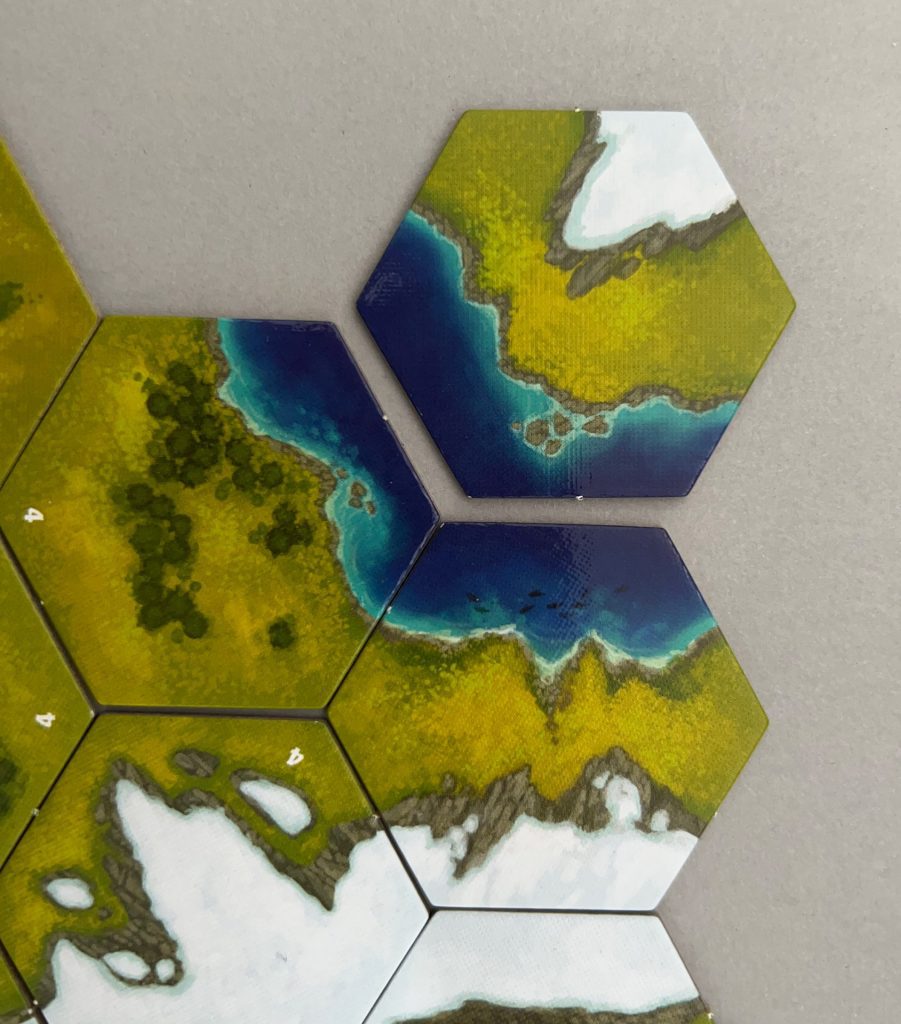
The Exploration Phase
Fjords is divided into two phases. The first of these is the Exploration Phase.
Here, players will draw hexagonal pieces from the bag to be placed on the board.
Importantly, if you draw a piece that can be added to the board, it must be added. If there are multiple places where the tile will fit, you may choose where to place the tile.
If you cannot place the tile because there are no legal places where it can be added, set the tile to the side within view of all players. Then draw another tile. If you cannot legally place that tile as well, set it aside and draw yet another tile. You will repeat this process until you draw a tile that can be added to the board.
Once a tile has been placed, the bag is passed to the next player.
If there are unplaced tiles set to the side of the board, the current player may choose to place one of these tiles onto the board (if a suitable position on the board now exists) rather than drawing a new tile from the bag. Or they may choose to draw a new tile from the bag. It’s their choice.
As you are building this landscape, you’ll be seeking out the most ideal places to place one of your four Longhouses. This is because it is from these Longhouses that your Vikings will venture out to conquer—or Settle, as the game refers to it—new territory.
And territory is your key to scoring Victory Points.
The Settlement Phase
After you have added all the placeable tiles to the board, the Settlement Phase begins. Here, your Vikings will set out from your Longhouses in search of new land—specifically, the Plains—in which to Settle.
During the Exploration Phase, you’ll be extending the desirable Plain tiles into a single landmass. However, you’ll also be forced to include the inhospitable Mountains and Oceans, places where your Vikings cannot settle. Throughout the Exploration Phase it’s key to read the lay of the land, because Fjords is won or lost based on how well you send your Vikings out from your Longhouses to conquer Settle new territory.

To get a better idea of this concept, let’s take a look at the upper North East section of the two-player game in the last game-play image. After moving to the Settlement phase, the purple and yellow players have each placed a single Viking onto the board.
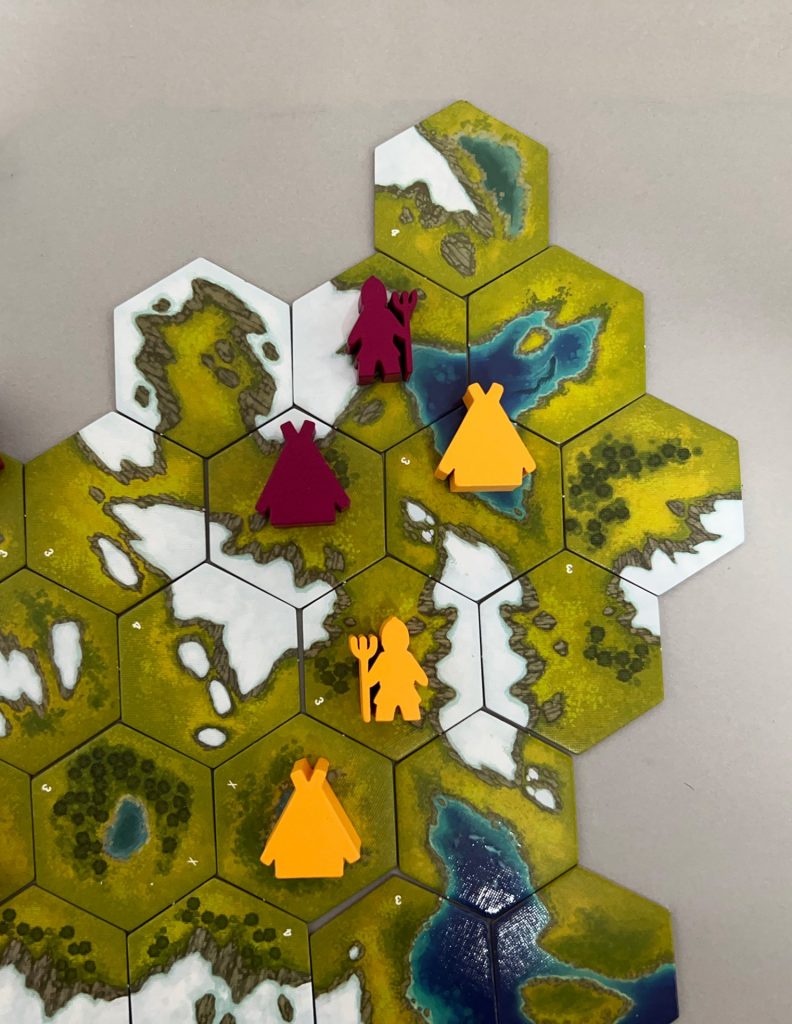
Yellow moved first, choosing to place a Viking between its two Longhouses. This cut Purple off from that space and preserved the eastern edge of the board for Yellow. Purple must place a Viking onto a Plain tile directly connected to its own Longhouse. Purple would like to stake a claim to the territory over the mountain, adjacent to the tile controlled by the lower Longhouse and Viking placed on the board, but Purple cannot cross over the mountain. Instead, Purple pushes a claim to the top of the map, as well as to the territory to the far left.

If the Exploration Phase, with its land-building and Longhouse placements, is the positioning of troops, the Settlement Phase is the final skirmish that decides the winner. As such, it is considerably shorter than the Exploration Phase. After building the board, one tile at a time, even with all 64 tiles, placing Vikings on the board is a series of quick, well-considered decisions, with land disputes raised and settled quickly.
The New Edition Tiles
A quick breakdown of the tiles in this new version:
- A two-player game has 40 tiles.
- A three-player game adds 17 additional tiles (for a total of 57 tiles).
- A four-player game adds an extra 10 tiles (for a total of 67 tiles).
The New Edition Runes
The new edition of Fjords comes with seven Runes, tiles with markings on them to denote special abilities within the game.

These Runes, designed by Phil Walker-Harding, are best considered as mini-expansions. Let’s take them one by one:
- Each player starts the game with a Home Rune. When placing a Longhouse on the board, a player may choose to play their Home Rune underneath it. During end-game scoring, any of that player’s Vikings connected to the Home Rune Longhouse will score +1 for the player.
- The Strength Rune means that when the Mountains-only tile is added to the board, this Rune must be placed atop it. Vikings belonging to any player that are placed adjacent to this tile gains +1 in end-game scoring.
- When the lone tile with the Water Rune is added to the board, you will place the corresponding Rule marker on it. During scoring, any Viking on a tile connected to the water flowing from that Water Rune tile scores an additional +1.
- Friendship Runes are set to the side at the start of the game. Whenever a Plains-only tile with a Friendship Rune on it is added to the board, adds a Friendship Rune to that tile. During end-game scoring, whichever player has the most Vikings adjacent to each Friendship Rune scores an additional +2 points.
- Journey Runes are also distributed, one per player, at the start of the game. While still holding a Journey Rune a player may, during the Settlement Phase, choose to not draw a tile from the bag. Instead, they may play their Journey Rune and preemptively place one of their Vikings on a vacant tile that is 1-3 tiles away from one of their Longhouses, provided it is connected by water.
- Horse Runes are also given to each player at the start of the game. Similar to how a Journey Rune allows a player to preemptively place a Viking down a flow of water, playing a Horse Rune will let a player preemptively place a Viking down a mountain chain extending from a Longhouse of their color.
- Each player starts with a Wisdom Rune. These are placed during the Exploration Phase to ‘bridge’ a blank space in the board. The player then places one of their Vikings on the Plains of a hex on the other side of the Rune.
Clearly, these can be mixed and matched, added a few at a time or all at once to the new iteration of Fjords.
A Quick Comparison
For those of you, like me, who own the 2005 edition of Fjords, your initial questions are likely to be, “What’s the difference in the two games?” and “Should I buy this new version?”
You already know the original version only has Longhouses and pieces in two colors; the 2022 version has pieces to support up to four players. You’ve also already read about the new Runes that can be added as you’d like.
So, what else is there?
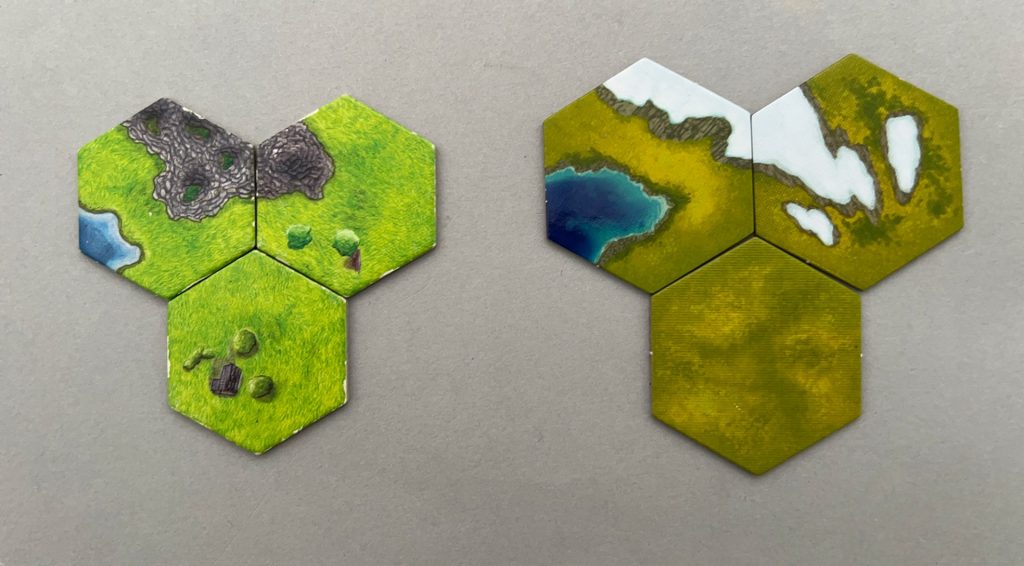
The new tiles are bigger and feature new artwork.
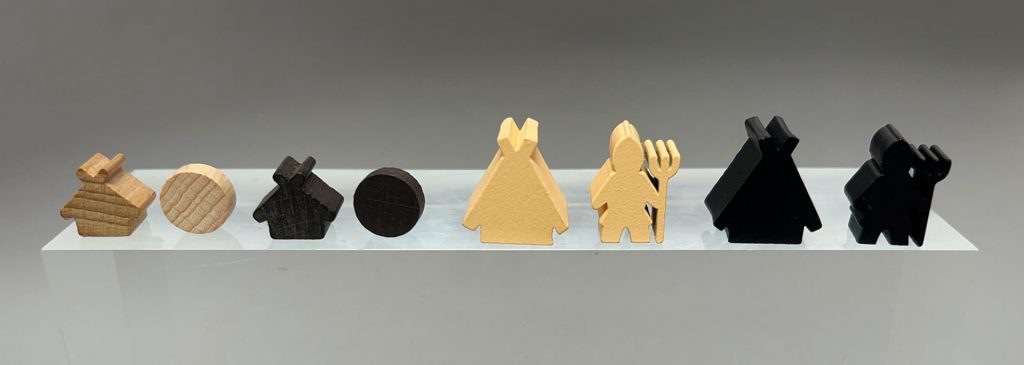
The new Longhouses are also bigger. You claim territories not with simple round wooden markers, but with Viking Meeples carrying…pitchforks? Tridents? Viking-like Implements of Destruction?
Regardless, they definitely look more impressive than round discs.
But is that really enough?
Thoughts, and Two Elephants
I have a long history with the original edition of Fjords. As such, I purposely tried to come into this newer version of Fjords with an open mind: New game, New Runes, New possibilities.
And yet, within just a few turns, I was already seeing tile placement limitations that I had ‘corrected’ with my Mega-Fjords tiles (see accompanying article).
However. Allow us to continue.
This new edition of Fjords brings back a great game to a new audience. Kickstarter creators seem to believe they must give the board gaming community something extra in a board game revival. It’s not enough to bring back an out-of-print game, they believe gamers will only back it if it has something new, something bigger and brighter, something that clearly improves upon that original game that they felt was worthy of bringing back into print. They need to make the new version that much more desirable.
Do they succeed with this edition of Fjords.
No. Not really.
It was good teaching Fjords to my current gaming group. They had heard of my love of the original game, but I’d never brought my custom-made Mega-Fjords to the table, largely because it was still a two-player game.
Elephant #1
So, Big Elephant in the Room Time: If you own the 2007 version of Fjords do you need to buy the new 2022 version?
No.
Honestly, unless you crave more tiles, the original edition of Fjords is just fine. Does it really need a three and four player expansion? I’m still not convinced. Sure, the Settlement Phase is tighter, with decision forks branching off much faster. If that’s enough to have you consider augmenting your collection with another version of Fjords, by all means, buy it. If not, seriously, you’re fine with the copy you already own.
Elephant #2
And Elephant #2: If you don’t own the older version, should you consider buying the 2022 version of Fjords?
If anything at all appeals to you about this game, then yes.
Definitely yes.
I say that not just as a fan of the original version. The simple truth is, if you like tile-laying games, or if you like Carcassonne at all, Fjords deserves serious consideration. It’s just familiar enough to pick up quickly, and just different—and tight enough—to make you smile and appreciate the differences.
Fjords can be a deceptively calm game to start. The Exploration Phase will take ¾ of your game time as you build the landscape. After that, it’s a quick series of skirmishes over land as you send your Explorers out and use your Runes to score points. Given that a game can easily be decided by only a few points, you’ll need to attack and react quickly to secure those points.
And, sure, extend the new version to four players if you want. The game play won’t be overly affected.
Beth Sobel’s new artwork is fine, but it doesn’t really make the new tiles stand out that much better. The new tiles may be bigger, but that doesn’t make for a better game.
And the Rune Tiles? Yeah…
I approached the Rune tiles with a mixed attitude. Show me you’re worthy of a place in this game, I thought. And did they? For the others in my gaming group (who had not played Fjords before) the Runes were a hit. The ability to reach into otherwise blocked off areas to score points made a big difference. Targeting the plains for extra points was a plus as well. Me, I’m a bit too You Kids Get Off My Lawn about the game, so I’m not as big a fan of the Runes.
That being said, I am willing to play the new version of Fjords with the Runes with my group whenever the game hits the table. (Although I’d still rather play my Mega-Fjords.)
I’m glad Fjords is getting a chance to impress a new generation of gamers. I hope you’ll be one of them.







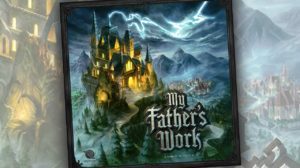




Add Comment